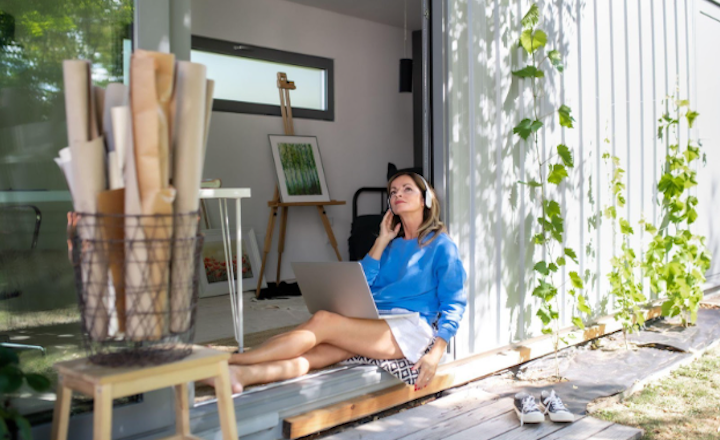
Shipping containers can offer fast, flexible office space, but need more than just cosmetic work
Local council approvals, delivery access, and comfort are key early considerations
Thermal performance, lighting, and ventilation make or break long-term usability
Knowing when to DIY and when to bring in professionals saves time, money, and future issues
The idea of converting a shipping container into a home office sounds like a simple solution to a modern problem. You get a private space, a quick install, and a sense of separation from the rest of the house. If you're working remotely or freelancing, the appeal is obvious. However, while the concept seems straightforward, making it work requires more thought than simply placing a box in the backyard.
If you’ve found yourself eyeing second-hand containers online or sketching out floorplans on the back of an envelope, you're not alone. More Australians are exploring this option as traditional building costs rise and councils become more receptive to flexible use spaces. Still, it’s worth understanding the absolute limits and possibilities before making any decisions.
What Makes Containers Appealing for Home Workspaces
There’s a reason container conversions have taken off over the last few years, especially in areas where residential blocks are shrinking. Containers are compact, structurally solid, and relatively quick to source. For people with limited yard space or no spare room indoors, they offer a separate, self-contained environment that doesn’t require extending the house or signing a lease elsewhere.
Cost plays a big part too. Compared to traditional renovations, the upfront spend for a container fit-out can seem refreshingly manageable. If you already work from home, investing in a quiet, purpose-built space could mean fewer distractions and a better work-life split.
Then there’s the speed. A container can be delivered in a matter of days, and with the right fit-out, be up and running within weeks. It’s an especially attractive option in regions where trades are booked out months in advance and building approvals are slow to process. Add to that the sustainability angle—reusing existing structures—and it’s easy to see why containers are getting a second life as workspaces.
The Practical Realities Most People Overlook
That all sounds great, until reality catches up. The first hurdle is usually local regulation. Councils vary wildly in what they’ll allow, and just because a container can physically fit doesn’t mean it’s legally permitted. Noise concerns, setbacks, fire ratings and visual impact all come into play. Without prior approval, you may end up with a workspace that is technically not permitted.
Another common surprise is the logistics of delivery. Getting a container into your backyard may seem simple on paper, but tight driveways, power lines, fences, and even soil conditions can quickly complicate things. Many people interested in buying shipping containers in Sydney are caught off guard by site access issues and strict council zoning regulations.
Then there’s the container itself. If it's been used for years on cargo runs, the structure may be dented or rusted in places you can’t see at first glance. Floors often contain chemically treated timber, and insulation is non-existent. Turning a bare metal box into a liveable space requires more than just a paint job and a desk. Without proper thermal control, you’re left with an oven in the summer and a fridge in the winter.
Even when all the pieces come together, comfort can still be a challenge. Sound echoes, lighting can be poor, and airflow needs to be managed carefully if you want the space to feel anything like a proper office. Those problems can be fixed—but they need to be accounted for upfront, not as an afterthought.
Making It Functional Without Breaking the Bank
Once you’ve locked in the structure and site logistics, the real work begins—making it usable. Many container conversions start strong but stall when the practicalities set in. People often underestimate the significance of small changes in such a confined space. Basic things like airflow, lighting, and elevation off the ground make a noticeable difference to how the room feels over a full workday.
Windows help, but placement matters. Too many people install a single pane at one end and end up with a dark, tunnel-like office. Skylights or clerestory windows can do a better job of pulling light through the space without sacrificing privacy. The same goes for ventilation. A container with no crossflow traps heat quickly, especially in the warmer months. Passive ventilation options, such as whirlybirds or louvred vents, are more cost-effective than complete air conditioning and can make the container usable year-round in milder climates.
Flooring is another area where people often skimp. Basic plywood subfloors might work in the short term, but insulating underneath and adding a sealed finish helps with both comfort and damp protection. And if your container sits directly on soil or grass, you’re risking long-term corrosion and poor drainage. Raising it slightly on a concrete pad or footings can prevent moisture problems before they start.
For furniture, compact designs are most effective. Wall-mounted desks, foldaway shelving, and built-in storage help avoid clutter. It doesn’t need to look like a tech startup’s breakout room, but it does need to function like a real office. That means good task lighting, reliable power, and ergonomic setup—none of which should be afterthoughts.
When to Get Professional Help (and When You Might Not Need It)
There’s a fine line between DIY-friendly and legally risky when it comes to container fit-outs. Painting the interior, laying a floor, or installing flat-pack furniture? Most people can handle that without trouble. But once you start cutting openings into walls or connecting to mains power, you're in licensed trade territory—and for good reason.
Structural modifications, such as window or door cutouts, can compromise the integrity of the container if not performed correctly. Reinforcement is sometimes necessary, especially when planning to add multiple openings or stack containers. These aren’t just cosmetic changes. Done incorrectly, they can lead to warping or even collapse over time.
Electrical fit-outs must comply with Australian safety standards, and insurance companies often won’t cover any damage caused by non-compliant wiring. The same goes for plumbing if you’re adding a bathroom or kitchenette. Even if your build looks tidy, skipping permits or sign-off can cause headaches later, especially if you sell the property or make an insurance claim.
That said, not everything needs to be outsourced. Painting, basic insulation, and even some timber framing can be handled without much experience, as long as you're working safely and staying within the legal bounds. Just make sure you’ve a clear plan for what you’re taking on yourself and what requires a qualified professional. Getting it right the first time is usually cheaper than fixing mistakes later.
Can You Actually Work in One Year-Round?
A container might seem like a solid, weatherproof shell—and it is—but that doesn't mean it's comfortable without upgrades. Australia’s climate extremes can turn an uninsulated container into a heat trap by midday or a freezing box by early morning, depending on the season and where you live. That’s fine if you’re using it as storage. Not so much if you’re planning to spend eight hours a day inside it, trying to work.
Insulation is where many people try to save money, but it’s rarely worth skimping. Basic foam panels will slightly dampen heat gain, but proper insulation—such as rigid board, spray foam, or rock wool—makes the space feel more like a regular room. Paired with good window placement and passive ventilation, it can make a significant difference in how usable the space is during summer.
You’ll also want to consider airflow. Even well-insulated containers can become stuffy without movement. Ceiling fans, vents, and even small split systems can keep the air moving and humidity low. For areas with extreme temperatures, air conditioning may be necessary, but intelligent design choices can reduce the amount of work it needs to do. A shaded position, reflective exterior paint, or even a planted screen can help cut the heat before it enters the structure.
Lighting also affects how comfortable the container feels. Harsh fluorescents or single downlights can make the room feel clinical or dim. Natural light through double-glazed windows, complemented by task lighting, gives the space a far more inviting feel—something you’ll appreciate when you’re on your fourth Zoom call of the day.
Ultimately, the goal isn’t just to make the container functional. It’s to make it feel like a place you’d want to spend time in. With the proper planning and a few smart decisions, it can be precisely that.
| < Prev | Next > |
|---|




